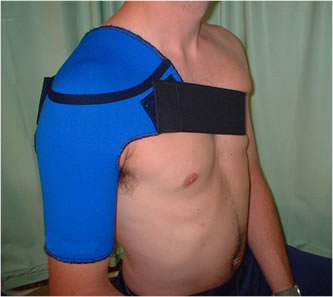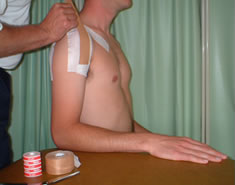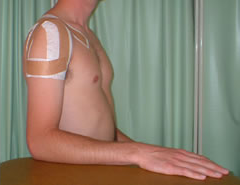There are numerous variations in supports available for hemiplegic shoulder pain. Their aim is to re-align the shoulder complex into a normal position.
The success or failure of these supports is often associated with:
- The complexity of the design which affects application
- The patient’s compliance with wearing the support
- Staff compliance with the support wearing schedule
- The patient’s size – off-the-shelf designs may not be suitable for all patients
- The extent of the paresis and extent of the patient’s involvement in physical rehabilitation
- The severity and irritability of the pain

See left for an example of such a support:
Cochrane review on the use of supportive devices for the shoulder following stroke
Strapping can be used as a custom made solution for re-alignment of the shoulder which may be effective in reducing pain in the acute setting. Clinician judgement and care must be exercised in deciding the length of time of the application as there is a risk of skin breakdown.
The photographs below show shoulder strapping being applied:


Cochrane comparison of shoulder strapping techniques
Devices:
Electrical Stimulation (ES): is a treatment modality which uses electrodes applied to the skin which stimulate the muscles to contract. It has been shown that ES decreases subluxation and shoulder pain in post acute care following stroke. These benefits may not be maintained beyond 6 months.
Other pain relieving modalities may include:
- Acupuncture
- Transcutaneous electrical nerve stimulation (TENS)
- Ultrasound
- Interferential therapy
Cochrane review on physiotherapy for shoulder pain
Page last reviewed: 25 Feb 2021


